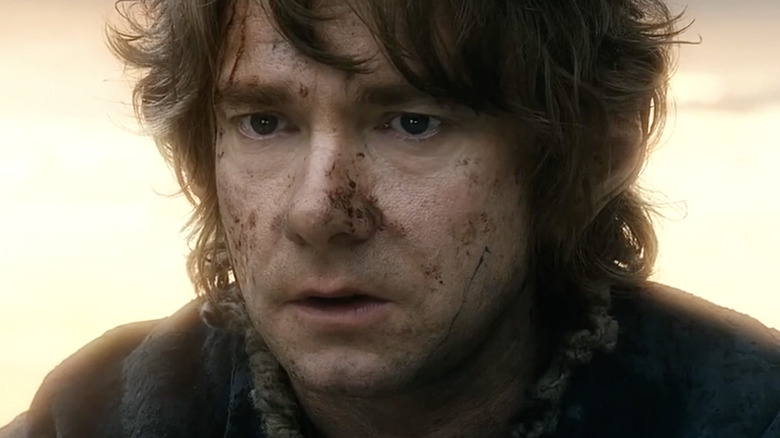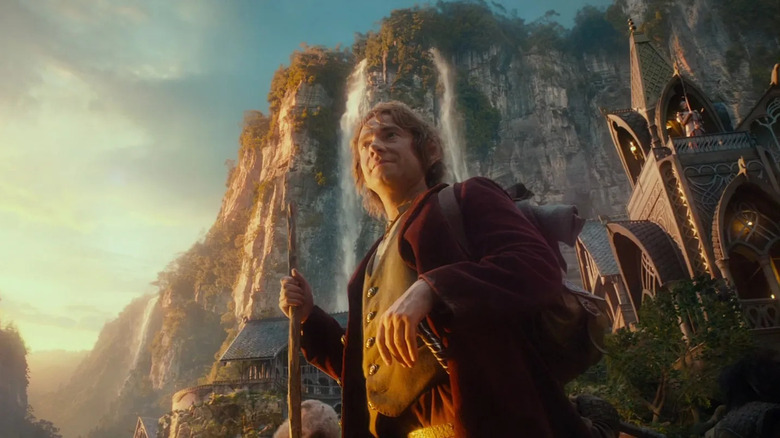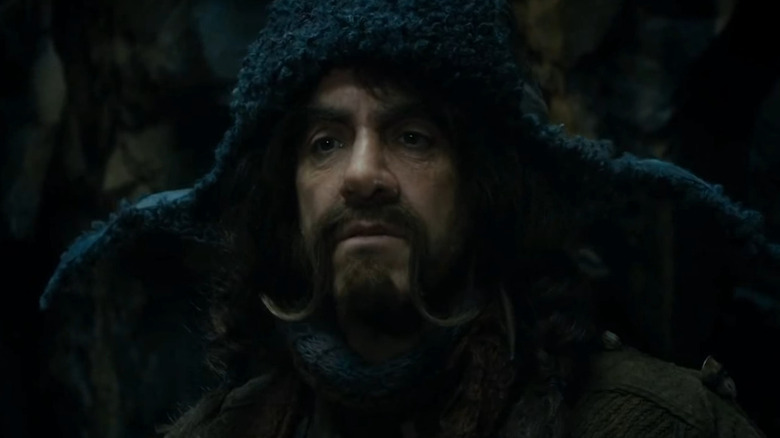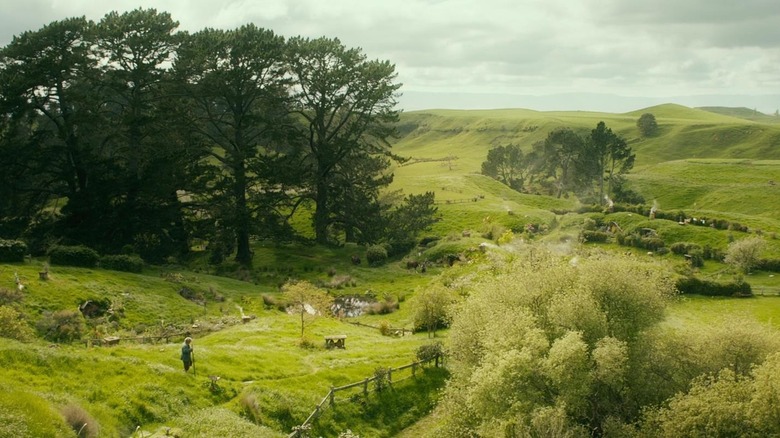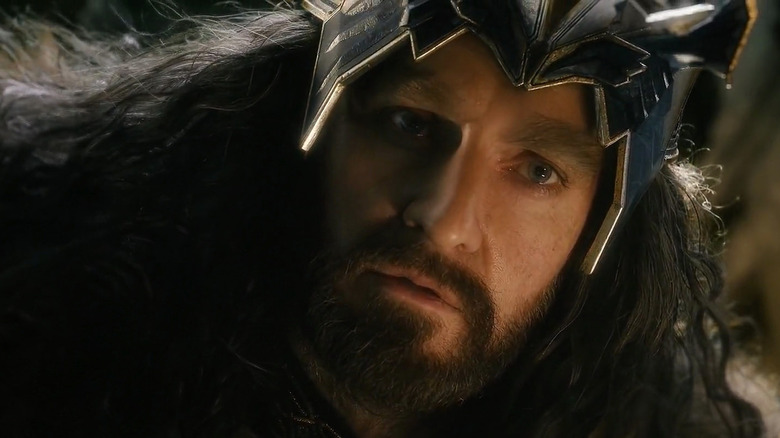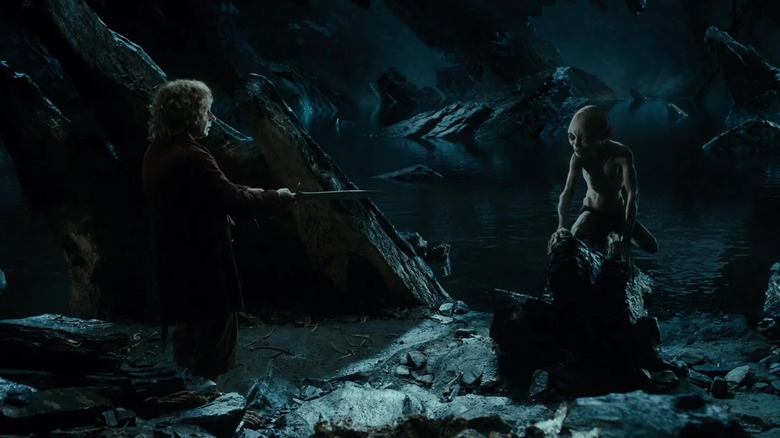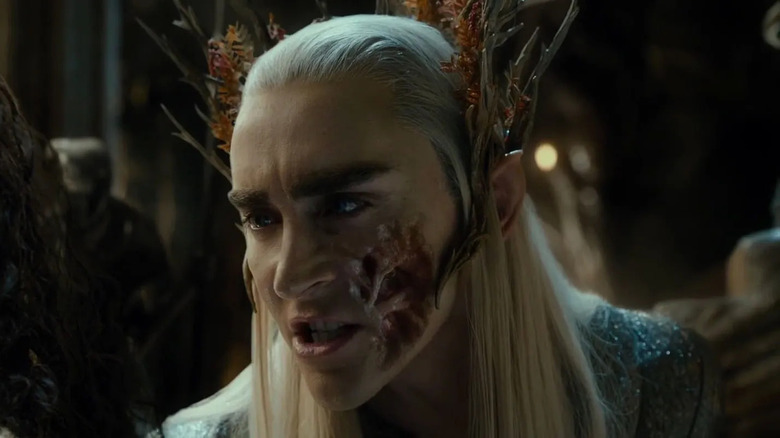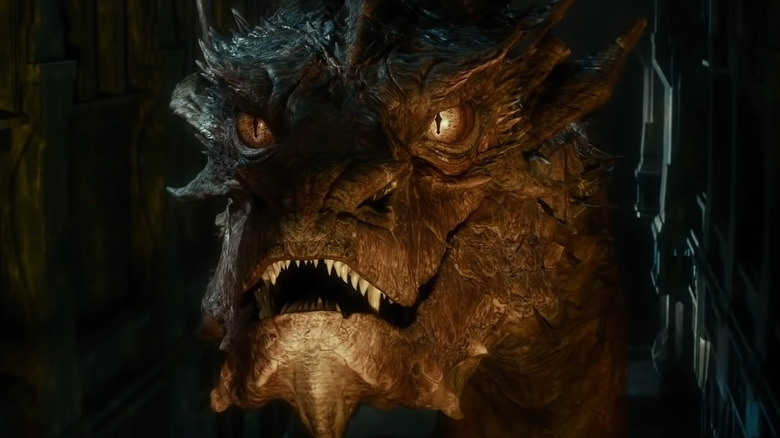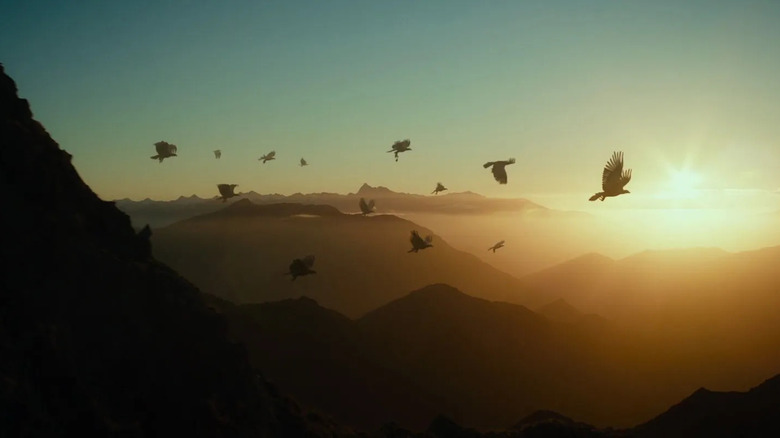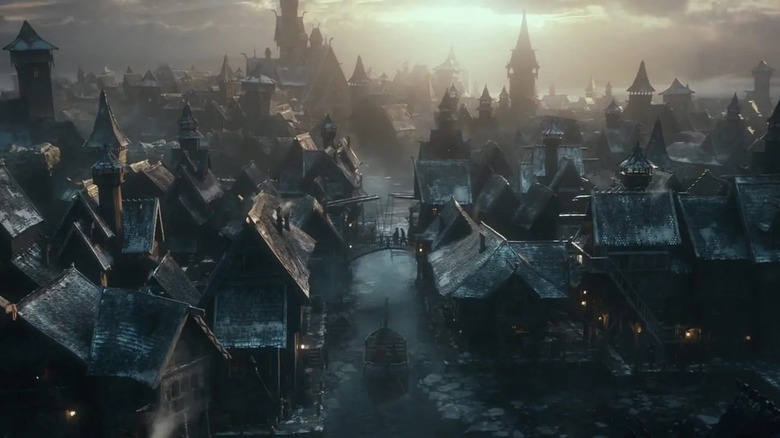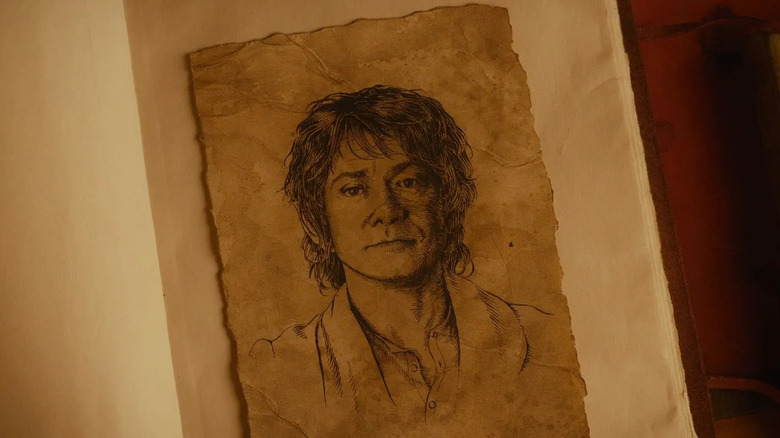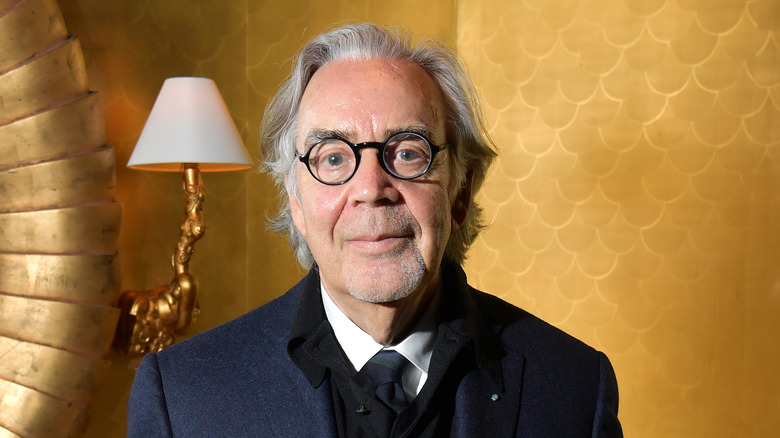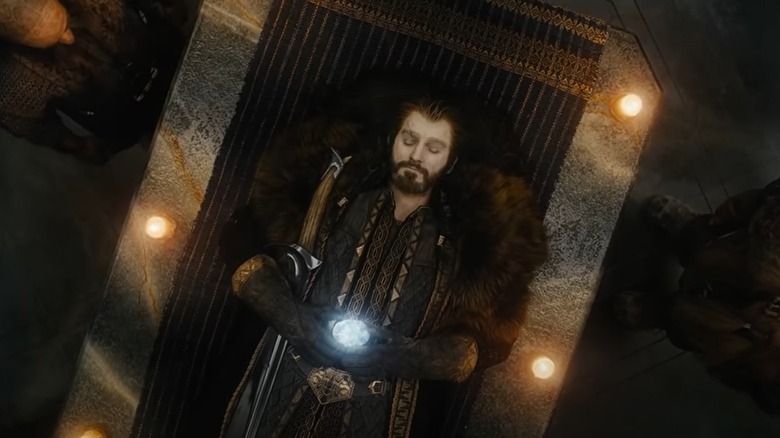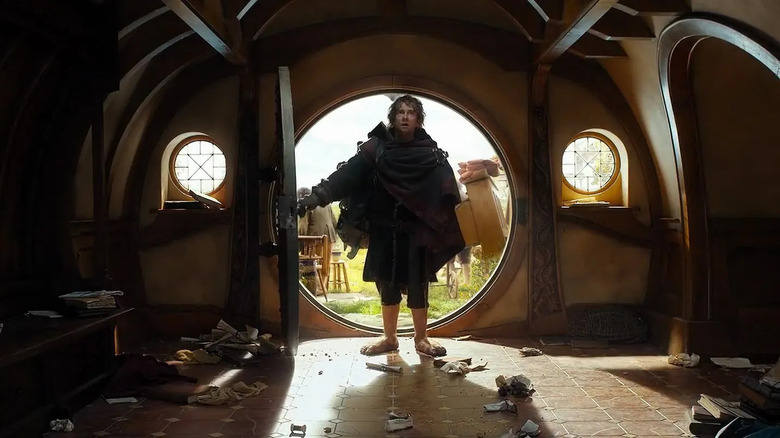Why The Hobbit Movies Are Better Than You Remember
The "Hobbit" film series, a three-movie adaptation of J.R.R. Tolkien's timeless children's novel, hit theaters from 2012 to 2014. Starring Martin Freeman, Ian McKellen, and Richard Armitage, these three films — "The Hobbit: An Unexpected Journey," "The Hobbit: The Desolation of Smaug," and "The Hobbit: The Battle of the Five Armies" — were, to put it diplomatically, not particularly well-received.
It wasn't a total disaster: The trilogy made a combined total of roughly $2.9 billion at the global box office, while the first two movies earned passable reviews. However, "The Battle of the Five Armies" didn't fare so well, becoming the first Middle-earth movie to receive a rotten score on Rotten Tomatoes' Tomatometer. Worse still, the reception from fans and critics alike paled in comparison to the runaway success of the "Lord of the Rings" trilogy, which, just over a decade earlier, forever changed the face of blockbuster cinema.
Common criticisms of the "Hobbit" trilogy include an overreliance on CGI, an uneven tone, and the egregious addition of content not found in the novel. While it's hard to argue that these aren't problems in each of the three movies, it's also true that they actually have a lot going for them — more than you might imagine, in fact. This is why the "Hobbit" movies are better than you remember.
Martin Freeman is the perfect Bilbo Baggins
If you're making a trilogy of "Hobbit" movies, you're going to need a decent Hobbit. By 2012, Martin Freeman had built an entire career on playing the everyman, from "The Office" to "Sherlock" to "The Hitchhiker's Guide to the Galaxy." Casting him as Bilbo Baggins, the unassuming and courageous Hobbit who joins Thorin and Gandalf on their adventure, must have seemed like a natural choice. And boy, did Peter Jackson get it right. Freeman is the heart and soul of the "Hobbit" trilogy, delivering a performance that never fails to hit exactly the right notes. Take, for example, his comedic exasperation at the Dwarves' intrusion into his home; his subtle yet unnerving attraction to the One Ring; or his wonderful knack for grounding the story's epic narrative in the simple pleasures of home.
If anything, the real problem with the "Hobbit" trilogy is that Freeman's Bilbo is so underused – especially in the latter two movies, where his arc takes a backseat to characters like Thorin, Gandalf, and Bard. When Freeman is given his time in the spotlight, however, he more than proves his worth as one of the finest actors in Jackson's Middle-earth.
The Dwarves are handled surprisingly well
Aside from Thorin Oakenshield, most of the Dwarves play a surprisingly small role in the events of "The Hobbit." Some, such as Balin, are more prominent, but others display only basic character traits. A few might as well not be there at all.
That's nothing against Tolkien — "The Hobbit" wouldn't be more magnificent if Nori and Bifur had more to say. But credit where credit's due: Peter Jackson does a fantastic job depicting the Dwarves. It's not easy to produce a movie that follows a cast of 14 (including Gandalf), but the Dwarves in Thorin's company genuinely feel like individuals. Neat visual touches help, like the axehead jutting out of Bifur's forehead, Balin's white hair and beard, and Fili and Kili being made to look like January and February on Erebor's T.A. 2941 Dreamy Dwarves Calendar.
Jackson and his writing partners, Fran Walsh and Philippa Boyens, also manage to insert a number of character moments for the Dwarves that don't exist in the novel. Bofur has a nice moment with Bilbo in "An Unexpected Journey" that is echoed in the final movie, for example. Meanwhile, much is made of Balin's long friendship with Thorin, and Kili is — for better or worse — afforded an entire storyline. All this prevents the Dwarves from becoming little more than extras in their own adventure. They add depth to Thorin's quest and deftly complement the trilogy's lead characters.
Everybody loves the Shire
"An Unexpected Journey" spends a staggering 40 minutes in the Shire. We visit Bilbo and Frodo, see Bilbo's first meeting with Gandalf, take in the Dwarves' arrival at Bag End, get some hefty plot exposition about Thorin's quest, enjoy a stirring rendition of "Far Over the Misty Mountains Cold," and, finally, watch Bilbo's departure. It's a lot — and the Extended Edition contains even more.
While this doesn't necessarily work in favor of "An Unexpected Journey," it does work in favor of the trilogy as a whole. The first movie's insistence on languishing in the Shire helps contrast Bilbo's comfortable, pleasant home against the high stakes and horrific dangers of the world beyond. When Bilbo tells the Dwarves he misses Bag End, you really believe it. When he returns at the end of "The Battle of the Five Armies," it feels as much of an earned homecoming as that of the Hobbits in "The Return of the King."
Plus, if nothing else, it's wonderful to spend more time in Peter Jackson's Shire, which provides some of the most enjoyable scenes in "The Fellowship of the Ring." This is a colorful, amusing, and beautiful part of Middle-earth, and it's an absolute joy to visit it.
Thorin's madness is better portrayed
As Tolkien's novel marches on, the early chapters' quaint adventures give way to something darker: Thorin, overcome by greed and obsessed with his search for the Arkenstone, fortifies the Lonely Mountain and threatens war against both Men and Elves.
Thorin's descent into madness makes for one of the most gripping character arcs in the trilogy, and one of the best parts of "The Battle of the Five Armies." This arc is set up as early as the Extended Edition of "An Unexpected Journey," and develops gradually and convincingly over the course of three movies. Armitage's terrifyingly erratic performance transforms the character from an inspiring leader into a Dwarf as willing to wage war against the victims of dragonfire as he is to toss a Hobbit over the ramparts of Erebor.
This all climaxes in an intense and hallucinatory sequence that sees Thorin literally consumed by the gold he desires. The payoff? The king casts off his crown, overcomes his family's terrible legacy, and rallies his allies in the battle raging outside. The whole subplot is masterfully executed, and can arguably be counted as one of the few ways in which the "Hobbit" movies actually improve on Tolkien's book.
Riddles in the dark
Gollum's part in "The Hobbit" might be brief, but it's crucially important to Bilbo's journey and the history of Middle-earth. During their encounter beneath the Misty Mountains, Bilbo discovers the One Ring, defeats his corrupted foe in a game of riddles, and makes good his escape. His subsequent decision to spare Gollum sets off a chain of events that ends with the final destruction of Sauron.
It's hard to understate how much "An Unexpected Journey" needed to nail this scene. Thankfully, the movie more than meets its mark. Jackson shows a degree of restraint rarely found in the rest of the trilogy: This is simply two stellar actors doing what they do best. Andy Serkis demonstrates an especially remarkable ability to switch from comic giddiness to furious rage to tragic heartbreak in the blink of an eye, and the mo-cap technology used to transform him into Gollum holds up over a decade later. Plus, the dialogue is nearly identical to what's in the novel.
Then you have that final, vital moment in which Bilbo's pity saves Gollum's life. It's easy to overlook this, since it's wedged between the cartoonish escape from the Goblin King and the bombastic hillside showdown with Azog. But there's something about the direction, the score, and — of course — Freeman and Serkis that makes the scene truly magical, and entirely worthy of its pivotal role in the wider mythos.
Thranduil and the Woodland Elves
Like the books on which it's based, the "Lord of the Rings" trilogy focuses on two particular Elven settlements: Rivendell and Lothlórien. The Elves of Rivendell are friendly and welcoming, healing Frodo after his flight from Weathertop and playing host to the Council of Elrond. The Silvan Elves of Lórien are more mysterious, but Galadriel and Celeborn nevertheless host the Fellowship and see them off with a number of gifts.
The Mirkwood Elves are an entirely different kettle of fish. Here, the Elves are dangerous at best and outright antagonistic at worst, first locking up Thorin's Company and later marching to Erebor to face them in battle. Rarely are Tolkien's Elves portrayed with such moral ambiguity — outside "The Silmarillion," at least — and the movies do a fine job of making them as threatening as any of the other foes encountered by Bilbo and his friends.
Central to this, of course, is Lee Pace, who delivers an ethereal and unsettling performance as Thranduil, king of the Woodland Realm. Adorned in silver robes and a crown of twigs and leaves, Thranduil feels even more otherworldly than Galadriel, and could be a different species entirely from Elrond and Arwen. He's scarier than them too, executing orcs with aplomb and flexing his own immortality as he threatens his prisoners. Here's hoping that future adaptations of Tolkien's legendarium can bring us Elves as captivating and terrifying as Thranduil.
Smaug
Smaug is the closest thing "The Hobbit" has to a leading villain. Breaking the dragon's hold over the Lonely Mountain is the singular goal of Thorin's quest, and, while he only appears in a few scenes, Smaug firmly establishes himself as a memorable antagonist. One of his best moments arrives when he encounters Bilbo in the depths of Erebor.
In the movies, this takes place towards the end of "The Desolation of Smaug." From the moment he slithers out of his hoard of gold, Smaug feels deeply threatening, thanks to some strong CGI and a truly dedicated performance from Benedict Cumberbatch. The scene is made all the better for the sheer size of both Erebor and Smaug in relation to Bilbo. While we all know the Hobbit will make it out alive, Jackson really makes you think, for a second, that he might not be so lucky. Like Bilbo's riddles with Gollum, the Smaug confrontation also benefits from dialogue lifted directly from the book, making for one of the most faithful scenes in the trilogy.
Putting aside the ludicrous chase sequence with the Dwarves, Smaug's other stand-out scene is the attack on Laketown in "The Battle of the Five Armies." This is Bard's time to shine as much as Smaug's, and both characters get the thrilling, edge-of-your-seat showdown that they deserve. It's so good, in fact, that you can almost forgive them for cutting out the thrush.
The visuals are bold
There can be no doubt that the "Hobbit" movies went too heavy on the CGI. Much of that CGI contributes to some uneven visuals found across all three movies, such as the dark, confusing final chase in "The Desolation of Smaug" or the inexplicable bloom lighting of "The Battle of the Five Armies."
But that's not to say these aren't pretty movies. In fact, in their finest moments, they're downright beautiful. "An Unexpected Journey" is a gloriously colorful romp through the most visually arresting regions in Middle-earth: You've got the Shire, of course, but also a more vibrant Rivendell than the one seen in the previous trilogy, as well as a strikingly quirky depiction of Goblin-town. The Woodland Realm in "The Desolation of Smaug" is nearly as picturesque — and certainly as unique — as Lothlórien in "The Fellowship of the Ring," while the filthy, wintry landscapes of "The Battle of the Five Armies" provide a setting unlike anything else in the saga. And of course, you can't go wrong with New Zealand scenery, especially when it's captured with such sweepingly epic cinematography.
The production design is breathtaking
The production designer on "The Hobbit" was Dan Hennah, who previously scored "The Return of the King" an Academy Award for best art direction. His talent is on full display in the "Hobbit" trilogy. Bolstered by the wizards over at WETA Workshop, these movies feature some of the finest sets, costumes, creature designs, prosthetics, and props in the history of fantasy cinema.
Every last corner of Middle-earth is given its own distinct identity, which makes each culture seem real and the world as a whole feel steeped in history. Among the most impressive examples of this are Laketown, the Mannish settlement painstakingly brought to life using a full-sized set, and the psychedelic landscape of Mirkwood. That's to say nothing of the wonderfully offbeat touches given to the trilogy's more outlandish characters, such as Thranduil's elk mount and Radagast's fairy-tale forest home, Rhosgobel. There are countless other gorgeous tidbits most viewers won't even notice, from Beorn's hand-carved chess set to the books and scrolls in the Master's hall. The absolute passion and eye for detail demonstrated by the talented people involved in these movies is nothing short of breathtaking.
The sillier tone actually makes sense
The "Hobbit" movies are often criticized for featuring a sillier tone than "The Lord of the Rings." It's difficult to combat those criticisms by pointing out that the movies are based on a children's novel, because they also feature their fair share of violence, gore, and other adult themes. "An Unexpected Journey" is particularly rife with zany antics. Recall the trolls' slapstick bickering, the Dwarves' many songs, or the infamous showdown with the Goblin King.
There's a way to explain this goofy approach, though, and even square it away with the more somber tone of the "Lord of the Rings" trilogy: The first movie makes a point of explicitly framing this as Bilbo's retelling of his quest. We already know from "The Fellowship of the Ring" that Bilbo likes to tell a tale; it's not hard to imagine that he's prone to exaggeration every now and again. Perhaps the "Hobbit" trilogy's more extravagant moments are simply the embellishments of an imaginative Hobbit. This idea doesn't quite explain every creative choice, but it certainly justifies some of them.
Howard Shore is a genius
Howard Shore's score for the "Lord of the Rings" trilogy is one of the finest ever created. That's not just our opinion, either: The man won a slew of awards for his work. Even "The Lord of the Rings: The Rings of Power," which has otherwise forged its own path through Middle-earth, brought back Shore to compose its title theme.
Shore returned to score the "Hobbit" trilogy, and somehow managed to prove that lightning can strike twice. For these movies, he crafted a staggering array of themes and leitmotifs that play a vital role in shaping Bilbo's world. These include a creepy motif for Smaug, a gloriously majestic theme for Thorin, and the instantly recognizable Misty Mountains tune. Unsurprisingly, Shore also revived some of his most iconic motifs from "The Lord of the Rings," to generally tremendous effect.
It's no exaggeration to say that neither the "Hobbit" nor the "Lord of the Rings" movies would be what they are without Shore's genius. His work on both trilogies is absolutely astonishing.
The Extended Editions are even better
All six of Peter Jackson's Middle-earth movies are accompanied by Extended Editions, which feature a flurry of new and expanded scenes. In "The Lord of the Rings," these range from the benign, such as Legolas and Gandalf ending their contest in "The Two Towers," to the absolutely vital, like Saruman's death in "The Return of the King."
The "Hobbit" trilogy is no different. While many of the Extended Edition scenes don't bring all that much to the story, a few of them should probably never have been cut in the first place. "An Unexpected Journey," for example, lost a scene in which Bilbo explores Rivendell and is offered lodgings by Elrond, setting up his eventual departure from the Shire in "The Fellowship of the Ring." The journey through Mirkwood in the Extended "Desolation of Smaug" is far longer and more unsettling. Thorin's funeral in "The Battle of the Five Armies" Extended Edition is one of the most emotional scenes in the trilogy. If you're ever tempted to re-watch the "Hobbit" movies, try giving the Extended Editions a go — you might find yourself enjoying them a bit more.
Fan edits
Let's put our cards on the table: The "Hobbit" movies are incredibly bloated. The simple fact is, as any fan will tell you, this story didn't need to be a trilogy. In the years since it was released, many such fans have made attempts to recut the trilogy into something shorter and more palatable. The best have succeeded marvelously.
Back in 2019, a Reddit user compiled some of these fan edits into a post and helpfully described what makes them unique. "There and Back Again," for example, compresses the trilogy into a single three-hour movie, while "The Ironfoot Edition" offers a five-hour cut of the story. Perhaps the most intriguing is "J.R.R. Tolkien's The Hobbit," a four-hour movie with an intermission that cuts most of the superfluous content and puts the focus back on Bilbo's journey. And then you've got actor Topher Grace, who recut the trilogy into a two-hour movie back in 2018. As he told IndieWire, this helped him wind down after shooting "BlacKkKlansman."
A quick Google search reveals that the legality and morality of such fan edits is hotly debated. Still, their mere existence goes to show that, if you cut away some of the worst excesses of the "Hobbit" trilogy, you might just find a surprisingly faithful and moving adaptation of Tolkien's masterpiece, and one of the best action-fantasy experiences of the last decade.
